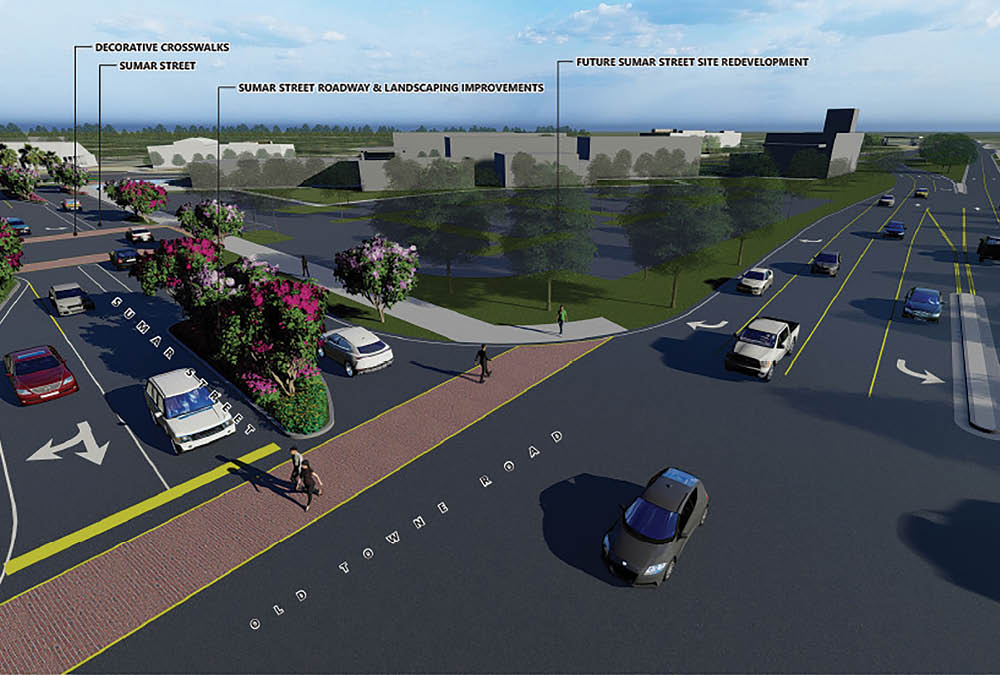Plan for former Piggly Wiggly site is finally starting to take shape
by Bill Davis | News Editor
Sometime this month, Charleston City Council is supposed to vote on turning over the redevelopment of the former Piggly Wiggly site, a 2-plus acre swath of concrete and weeds in West Ashley, over to a local developer.
The city’s ambitious vision for the site will be for a civic center, retail and restaurants, and a greenspace where the public can gather as the national economy roars back to life. The “civic center” will feature city offices, in part so that West Ashleyians won’t always have to go downtown to interact with city officials, and may also have a space and seating for performances.
This vote has been in the works for over a year, as the city began drafting a “memorandum of understanding” in June of 2020, according to a city timeline, with Landmark Enterprises, a local full service commercial real estate developer and the only applicant for the project.
That was back when COVID-19 was closing municipal buildings, stores, restaurants, and people were scared to get within six feet of each other as the national economy was grinding to a halt. Perhaps understandably, there was only one suitor to redevelop the site.
But the delay on the redevelopment stretches back further than last summer. The grocery store closed in 2013. The city purchased the site in 2017 rather than allow construction of a mega-gas station on West Ashley’s doorstep.
For three years, the city and the county danced around each other, as the city delayed unveiling its plans for the site until the county decided how to handle the “suicide merge” and other roads issues surrounding it.
Even when plans were complete over a year ago, the city Landmark Enterprises “hit a snag,” according to City Councilman Peter Shahid.
Shahid lives close to the intersection and chairs the West Ashley Revitalization Commission, which has played an advisory role to Council on the project.
Shahid would not divulge the nature of the “snag,” but said the long time it has taken to get the project almost started is worth the wait because “we’ve got to get this right.”
Jason Ward, president and principal at Landmark, shied away from commenting on the redevelopment project in specific, as negotiations are still underway.
In general, though, Ward says his company is committed to creating something that will bring “pride” to West Ashley and become an “amenity” for the area.
The redevelopment is not the only municipal project that hit a slow-down over the past few years. Recently, Shahid said Council voted to “fire” NBM, the venerable local builder who was seriously behind on construction of the city’s new fire station on Savannah Highway.
That fire station, next to the memorial park dedicated to the firemen who died in the Sofa Super Store fire, sits seemingly nearly complete with no crews working on it.
Not long ago, Shahid posed in the road for a photo for this publication, just short of the point where Sam Rittenberg Boulevard and Old Towne Road intersect. At the time, he said that he was going to “fix” the intersection or take the “blame or the responsibility” for however it turned out.
It’s 2021, and the roads are going nowhere. The intersection is not being diverted. The county, which only has dominion over this part of the project, has agreed to focus on improving intersections and bike/pedestrian crossings in the area.
County communications director Taylor Green confirms that last summer, the roads portion of the redevelopment was “essentially rebranded” after two public polls found locals preferred nothing be done to the intersection.
Green also lives a few blocks from the site and intersection.
Shahid admits that the work on the area, as far as traffic issues are concerned, isn’t done yet, and more will have to be done in the future.
“I said I would fix it. I didn’t say when I was going to fix it,” says Shahid, who has been joined by Mayor John Tecklenburg in saying that a complicated project like this one necessitated extra time.
One of the issues that makes this project more complex is the inclusion of commercial property in its midst. Rarely do cities and their planners consider issues like “return on investment” in projects.
Usually, the use the public gets from a project is enough. But with the inclusion of retail space in the project, the city had to take on an extra layer of work.
The city and the WARC have for years have been looking for ways to revitalize the Sam Rittenberg corridor extending down from the former Citadel Mall to the intersection, so including a commercial component makes sense.








